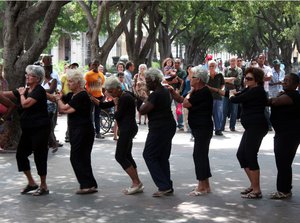Advertisement
Published: March 26th 2011

 Prado
Prado
There's usually some entertainment on a SundayCentro Habana
Centro Habana is the area around the
Parque Central and the
Capitolio. A wide avenue,
Prado, leads from the Malecon up to the Parque Central / Capitolio area. There is usually some activity on the
Prado at weekends. This may be kids entertainers or a display of dancing. On one Saturday there was a craft market along part of the Prado but, more interestingly, a bit further down there were groups of people trying to exchange houses. This is as close as Cuba gets to an Estate Agent. In Cuba people are not allowed to buy or sell property but they are allowed to exchange their homes. Sometimes you will see a sign in a window often wanting to exchange a large house for two smaller ones. On this occasion everyone wanting to exchange their homes seemed to be using the Prado as a gathering point.
Parque Central is a regular destination and meeting point for us. It’s where all the
collectivos arrive and depart to for Vedado. And, importantly, it’s where we catch the bus to get to he beach. The park itself is the home for a number of Havana’s older colonial-style hotels, the impressive

 Home Swappers
Home Swappers
This lady wants to swap her house for two smaller apartmentslooking
Gran Teatro and, of course, the obligatory statue of
Jose Marti. There’s plenty of life going on around the square. If you can escape the people offering you cigars, taxi rides and boyfriends/girlfriends there’s the permanent gathering of men {
no women} who meet here just to argue about baseball. I’m sure there would be many people back home who’d be more than pleased if there was just one corner in a park in each town which was the
only place where you were allowed to argue about football!
Not too far from the Parque Central is the
Bacardi Building, built by the Bacardi family {
obviously!}. The building is a fascinating piece of architecture in its own right but 2 CUC will get you a ride up the lift for some good views of the central area.
Museo De La Revolucion
A bit further down from the Bacardi Building is the
Museo De La Revolucion in the former presidential palace, well worth a visit. The museum is set out on three floors with the displays being mostly photographs from Cuba’s recent history. The top floor covers the period of the revolution while the floor below covers
the development of the country since the revolution. The displays are interesting enough and all have descriptions in English as well as Spanish but the language used still seems to be stuck somewhere in the Cold War. There are plenty of reminders that this was once a presidential palace – nobody seems to know what to do with the disused Hall of Mirrors.
On the ground floor there is the restored yacht
Granma, the yacht used by Fidel and the revolutionaries to cross from Mexico to Cuba, and a few other vehicles that were significant to the revolution. Unfortunately the restoration process seems to have been too good.
Granma is in immaculate condition and all the other vehicles have been restored and repainted. I’m sure that Granma is in much better condition now than when it first arrived in Cuba!
Chinatown
Behind the
Capitolio building and past a yard of disused railway engines and other vehicles (!!) is
Barrio Chino, Havana’s Chinatown. There doesn’t seem to be too much left of Havana’s Chinese population. There is one street,
Calle Cuchillo where there are a number Chinese restaurants and where some attempt has been made to decorate
the street. We walk straight past all the restaurants offering us free mojitos if we eat there and find something a bit more authentic in the
Tien Tan at the end of the street. This proves to be a good choice!
…And Some Strange Handshakes
It’s purely by chance that I discover that Cuba has a large number of Masonic Lodges.
We spot that an old gentleman,
Narciso, in the house where I’m taking Spanish lessons has a number of Masonic symbols in his room and he is very pleased to explain something about the history of the Masons in Cuba.
Fernando knows that there is a Grand Lodge in Centro Habana and one day we decide to take a walk to see the lodge. After taking a few pictures of the building I summon up enough Spanish to ask if we come in and take some photos of the murals and the statue of Jose Marti {
he was a Mason} in the foyer.
As we are about to leave the man on the door informs us that he is the director of the Masonic Museum and invites us to visit. The museum doesn’t
have any spectacularly exciting exhibits but, as someone who knows very little about the Masons and who didn’t expect such an organisation to have been able to survive the revolution in Cuba, I find the explanations fascinating. Even more exciting for me is the fact that the director,
Justo, speaks in a very slow, clear Spanish and I can understand most of the explanations!
Advertisement
Tot: 0.105s; Tpl: 0.012s; cc: 11; qc: 27; dbt: 0.0445s; 1; m:domysql w:travelblog (10.17.0.13); sld: 1;
; mem: 1.1mb
















